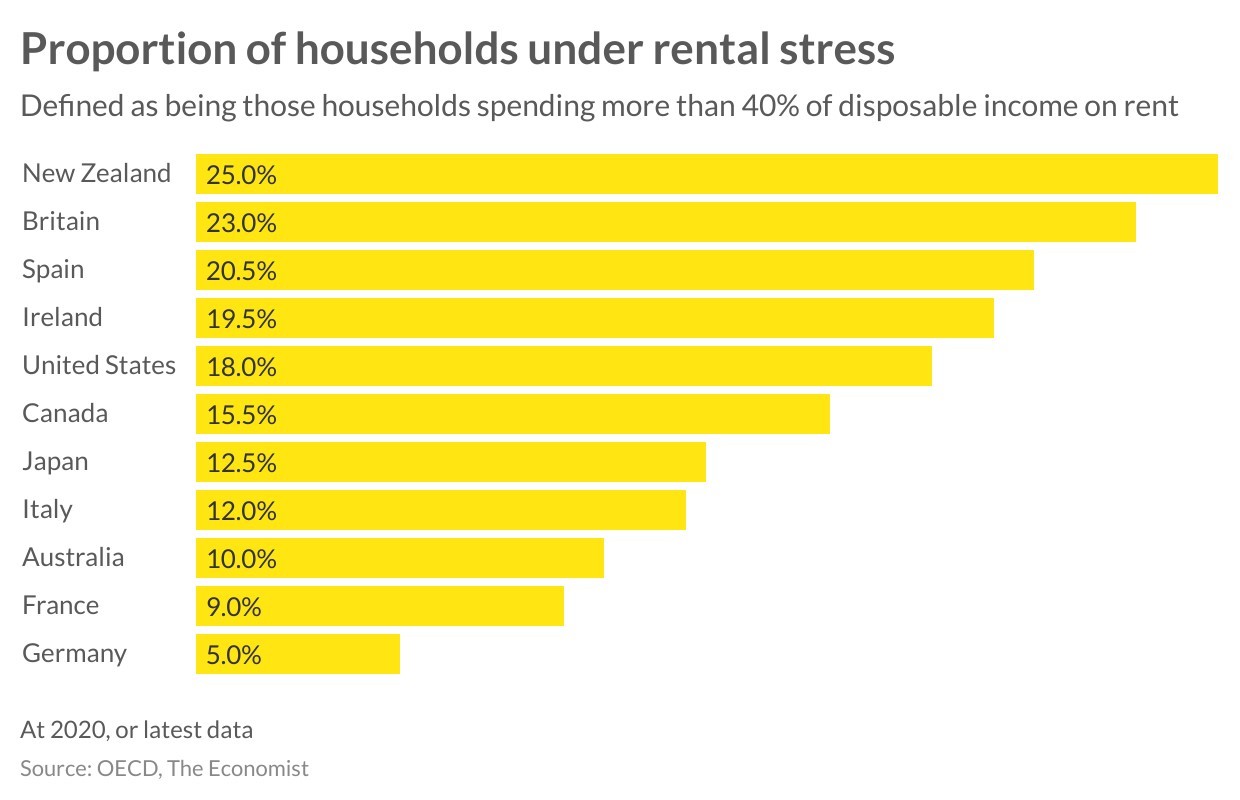Nerida Conisbee
Ray White Group
Chief Economist
Landlord incentives to provide rental housing have been overwhelmingly successful over the past 25 years.
With rents surging post-pandemic across Australia and a lot of discussion around who should be providing rental properties, it is timely to have a look at how Australia compares to the rest of the world for rental affordability. And more specifically, how successful our policies have been to provide adequate rental homes.
The Economist recently undertook an analysis into OECD data to compare the proportion of households that are seeing very high levels of rental stress. Australia is faring relatively well. Not as good as France or Germany but remarkably better off compared to New Zealand, Britain and the US.
It is likely that these levels are higher now. Across the world, including in Australia, we have seen rents surge post pandemic. As discussed in detail in previous weekly updates, it was driven by both a reduction in household size during the pandemic (people spread out) and then a return of high migration levels (not enough homes subsequently available). From Singapore to London and to smaller cities in between, the end of the pandemic resulted in double digit rental increases. Only now, as housing construction starts to get back to more normal levels and more people start to share again are we seeing these increases dissipate.

Although they are frequently criticised, incentives available to property investors in Australia have been overwhelmingly successful in providing a steady stream of rental properties and keeping the proportion of households under rental stress at globally low levels. Between 1996 and 2021, there were an additional 1.1 million rental properties provided by investors.
Compare this to an increase of 41,000 homes provided by community groups and more jarring, a loss of 53,000 rental properties provided by the government.

New Zealand highlights specifically the problems with not providing the right incentives to encourage greater supply of rental properties. It is clear that New Zealand had problems with shortages of rental properties in 2020. This was two years after foreign investment in property was banned in that country (foreign investors can play a major role in providing rental properties). However in 2021 they put in measures which will make it worse, no longer allowing tax deductibility of interest payments for investors. This was done without a plan for anyone else to provide a large number of rental homes.
Significantly, Australia would have been in a similar position to New Zealand if Labour came into power in 2019. At that election, it was a key promise that incentives available to owners of rental properties such as negative gearing and capital gains tax concessions would have been scrapped. Like in New Zealand, there was no back up plan as to who would replace these investors if such a change was implemented. Australia would have been in a much worse position than now if this policy had been changed.
At the other end of the spectrum, Germany’s post war rebuild and significant steps to provide high levels of provision of rental housing has led to a lot more people renting for life, and spending a lot less of their incomes on doing so. Like the rest of the world however, Germany is now having to take another look at rental provision due to similar problems facing the rest of the world. High levels of migration and underbuilding in big cities like Berlin, Munich and Hamburg have driven up rents significantly, making it no longer such a safe option to be a renter for life in that country.
While Australia has done relatively well on a global level up until now, we need a continued focus on policies impacting renters, and more particularly the supply of rental properties. For social and affordable housing, it is a relief that the $10 billion Federal Government Housing Australia Future Fund was finally passed, promising to provide an additional 30,000 social and affordable homes. Changes to rental legislation in most states and territories comes after decades of stagnation, finally recognising that more people rent for longer and there have been significant changes to family types. Build-to-rent is only ever likely to provide a very small amount of rental properties compared to traditional landlords but promises to supply a different kind of rental experience, particularly suited to those who want to live in apartments in suburbs with a high degree of amenity.

